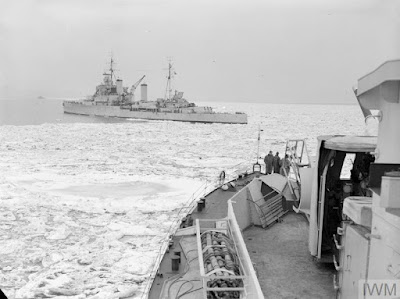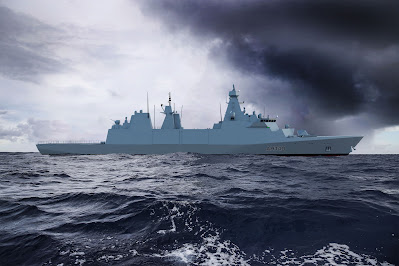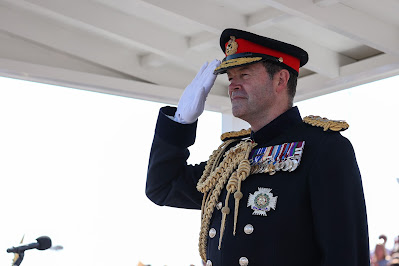The Royal Navy has been operating in cold climates for hundreds of years and most vessels in An Independent Navy For An Independent Nation shall operate throughout the United Kingdom,the British Overseas Territories and the Crown Dependencies (except the British Antarctic Territory) and shall be built to Lloyds Register notation Winterisation H,M,C to withstand extremes of temperature which they are likely to encounter in areas ranging from the Shetland Islands down to South Georgia,vessels expected to operate in the low Arctic seas from Canada to Finland shall be built to Lloyds Register notation Winterisation H,M,B and the Assistance class icebreaking tugs which shall operate in the high Arctic ice pack and around Antarctica shall be built to Lloyds Register notation Winterisation H,M,A.
Wednesday 26 July 2023
The Cold War
Labels:
An Independent Navy For An Independent Nation,
Antarctica,
Arctic,
Assistance Class,
Ice Pack,
Icebreaking Tug,
LLoyds Register,
Royal Navy,
Shetland Islands,
South Georgia,
The Cold War,
Winterisation
Monday 24 July 2023
Ice Ice Baby
There are reasons why every major warship in An Independent Navy For An Independent Nation shall be built to Lloyds Register Ice Class 1C.
Tuesday 11 July 2023
Going Ballistic
There are two kinds of people in this world,those who think small calibre,rapid firing guns are more effective than large calibre guns and those who have studied ballistics; until the twentieth century guns were the dominant naval weapon but since the ascendance of mines,torpedoes,aircraft and missiles interest in naval gunnery has declined,leading to a lack of knowledge of ballistics in naval circles and herein we shall look at two examples of this.
A recent article by NAVYLOOKOUT claimed that the elderly .50 Browning Machine Gun cartridge "is one of the few rifle cartridges that can boast a ballistic coefficient of 1.0" (the undefined coefficient is G1),which is technically true as there are high ballistic coefficient bullets available for that cartridge but their increased length and weight reduces muzzle velocity resulting in inferior performance at typical combat ranges but superior performance in the extreme long range target shooting competitions for which they are designed,which is why most military projectiles have a far lower ballistic coefficient but higher muzzle velocity resulting in external ballistics inferior to those of the Three Eights Inch Machine Gun proposed herein,which shall also be lighter and faster firing than the Browning Machine Gun.
The Navy Matters blog recently published an article titled "Naval Gun Accuracy" which appears to be about precision rather than accuracy and which states "We have to be down around 0.1 deg or less deviation to hit our predicted intercept point close enough to be effective" but then goes on to say "my estimate is that deviations of 0.5-5 degrees are normal",an overestimate of between one and two orders of magnitude (the precision of modern small arms is well documented thanks to hundreds of millions of target shooters and the precision of modern artillery is being demonstrated every day in Ukraine),one manufacturer claims a probable error in azimuth of plus or minus ten metres at a range of twenty thousand metres and given that a modern 155mm shell generates a lethal area approaching the size of a football pitch that implies a high probability of a one shot kill against static infantry in the open and is consistent with the performance of naval gunfire in the Falklands War where "Such was the accuracy of NGS that specific targets could be accurately engaged, including a radar aerial that was ‘toppled from it's plinth’ by HMS Glasgow.....It was quite accurate. In some cases, it was too accurate. They had to employ a spreading fire to make it less accurate because it was all coming down in the same place.....it was gauged that during Operation Corporate, a barrage of twenty-five rounds of 4.5” NGS would be dispersed within an area that was smaller than a tennis court".
The article also claims that "if we fire enough shells toward the predicted intercept point, one or some of them will, statistically, wind up being close enough to be effective. This argues for smaller caliber projectiles that can be fired quickly and in large numbers." but a missile flying at twice the speed of sound moves over two hundred yards in the time it takes a 57mm Bofors Mark 3 gun to fire a single shot and thus the firing of each round is a discrete event and since a smaller calibre projectile has a lower sectional density for any given form factor it decelerates more quickly,takes longer to cover any distance and consequently suffers more drop due to gravity requiring a higher trajectory with a longer flight path and longer time of flight,allowing the target more time to manoeuvre away from the point of detonation,a problem exacerbated by the smaller effective radius of the smaller shell,resulting in a lower kill probability,thus the conclusion that "if we’re trying to shoot down an anti-ship missile, we need small, light, very rapid fire guns" is the very opposite of the truth.
Labels:
57mm,
Aircraft,
Ballistic Coefficient,
Ballistics,
Bofors Mark 3,
Falklands War,
G1,
Going Ballistic,
Gun,
Mine,
Naval Gun Accuracy,
Navy Matters,
NavyLookout,
Precision,
Three Eights Inch Machine Gun,
Torpedo
Wednesday 5 July 2023
The Good That Men Do Is Oft Interred With Their Bones
In stark contrast to his predecessors,General Sir Patrick Nicholas Yardley Monrad Sanders' time as the Chief of the General Staff of the British Army has been a litany failure: failure to radically disorganise the army; failure to make it smaller but leaner and more agile; failure to waste thousands of millions of pounds on ill conceived and poorly executed procurement projects; failure to achieve a humiliating defeat at the hands of Third World peasants; and failure to speak using only buzzwords and acronyms (although he did once use the word "gift" as a verb,which is unforgiveable),all of which might explain rumours that he is to be replaced by someone more "suitable".
Labels:
Acronym,
British Army,
Buzzword,
Chief of the General Staff,
Disorganise,
General Sir Patrick Nicholas Yardley Monrad Sanders,
Leaner,
More Agile,
Smaller,
The Good That Men Do Is Oft Interred With Their Bones
Saturday 24 June 2023
An Independent Navy For An Independent Nation: Remember The Titan
Following the recent search for the submersible Titan which went missing whilst on a dive to the wreck of the Titanic,herein we shall discuss how An Independent Navy For An Independent Nation could contribute to such an operation.
Whether launched from the United Kingdom,Bermuda or an Africa class flying ship,with an endurance of twelve hours at five hundred knots a Perseus aircraft (at least forty of which could have been paid for with the thousands of millions of pounds spent on Nimrod,Sentinel,Reaper,Airseeker,Crowsnest,Poseidon,Wedgetail,Protector and Envoy) could quickly reach the search area and conduct a surface search with it's active and passive multispectral sensors and deploy a pattern of sonobuoys to detect noises from the submersible.
Beneath the waves at least one of the six Cachalot class and two Defence class submarines (which could have been built with the money spent on seven Astutes) could be in the search area within days,both having the ability to listen for sounds from the submersible and the latter also having the ability to manipulate items on the sea bed.
On the surface several of the twenty-four Duke,Royal Duke and Falkland class frigates (which could have been built for far less than the cost of six Daring class air defence destroyers,five River class patrol vessels,refits for Type 23 submarine defence frigates,repairs for Type 45 destroyers,eight Type 26 submarine defence frigates,five Type 31 point defence "frigates" and Type 32 mystery frigates) would likely be within a few days sailing of the search area with hull mounted and towed array sonars and Merlin or Hermes helicopters which could be helpful in search operations.
At least one of the Hecate class hydrographing sloops is likely to be in the North Atlantic area with it's hull mounted and towed sonars being able to locate items on the sea bed and its tethered submersible being able to investigate and manipulate them.
Two of the four Assistance class icebreaking tugs shall routinely carry a submarine rescue party to support underwater warfare with the Northern Division,whilst the other two shall routinely carry a ship repair party to support vessels on more distant stations,but due to their slow speed it is unlikely that they could cross the Atlantic quickly enough to be of any use.
However,His Majesty's Rescuing Tug Ranger on station at Bermuda shall be within about a day's sailing time of the Titanic wreck site and her heave compensated crane shall be able to lift the Titan but although designed to accommodate tethered submersibles,a salvage party and a submarine rescue party she shall not routinely carry them and they must be flown out to Bermuda before departure,a flight of around six hours for an aircraft such as the Centaurus.
Labels:
Africa Class,
An Independent Navy For An Independent Nation,
Assistance Class,
Cachalot Class,
Defence Class,
Falkland class,
Hecate Class,
Remember The Titan,
Royal Duke Class,
Titan,
Titanic
Saturday 3 June 2023
The Few
The Few,the handful of pilots who heroically defended the United Kingdom in it's darkest hour,or as racist and misandrist Royal Air Force officers might describe them: "useless white male pilots".
Labels:
Darkest Hour,
Misandrist,
Officers,
Pilots,
Racist,
Royal Air Force,
The Few,
United Kingdom,
Useless White Male Pilots
Wednesday 12 April 2023
The Transformational BAE Systems Archer Artillery System
The British Army has a long and unfortunate history of condemning soldiers to death by sending them in to battle with inadequate equipment procured on the grounds that urgency was more important than efficacy (during the Second World War two thirds of it’s tanks were obsolete before they even left the factory) and,as old habits die hard,herein we shall discuss it’s recent decision to procure the,fashionable,Archer Artillery System.
Picture: Grand Logistics
All armies organise themselves differently and are constantly changing but typically shorter ranged weapons are held at lower levels and longer ranged weapons are held at higher levels due to differences in their vulnerability,mobility,logistic demands,reaction times and effective ranges and weapons such as the Archer Artillery System are often held at the brigade or division level,usually operating within the range of enemy corps and divisional level artillery but without the range of enemy battalion level weapons.
Picture: Grand Logistics
When threatened by counter battery fire divisional artillery may engage the enemy front line from without the range of it’s counterpart,thereby limiting it’s exposure to enemy corps level artillery which if indirectly observed shall not be able to put rounds on target before even a towed artillery piece,such as An Independent Army For An Independent Nation’s proposed Field Gun,is able to complete a fire mission and leave the area due to the long time of flight but even then divisional artillery remains vulnerable to directly observed fire (the effects of which may be mitigated by an infantry screen,air defences,camouflage,obscurants and decoys) when conducting slow paced infantry operations.
As it is time consuming to detect,identify and destroy thousands of small,low value,targets which do not wish to be detected,identified and destroyed (clearing a small town of infantry often takes months) a manoeuvre force which rapidly advances in to enemy territory must do so through terrain which has not been thoroughly cleared and therefore it’s artillery shall be exposed to engagement by direct fire weapons such as the Kornet missile and directly observed artillery fire,the effectiveness of which increases,due to reduced dispersion and time of flight,as the force advances towards the enemy’s guns and for this reason a Royal Horse Artillery regiment in each heavy cavalry division of An independent Army For An Independent Nation shall be equipped with the Chaplain self propelled gun-howitzer (based on the same hull as the Royal Engineers' Chastiser assault howitzer) which shall have tracks,heavy armour and dischargers for decoys and obscurants.
To seize unoccupied terrain light forces must move faster than their medium and heavy opponents,a role which implies and is implied by road and air mobility,and for this reason every light infantry division shall be equipped with the Ox,Mule and Pony vehicles and the division’s artillery regiment shall be equipped with the Five and a Half Inch Gun Howitzer which may be towed on narrow roads or across weak bridges,carried by the Hermes helicopter or air dropped in quantity by the Centaurus aircraft.
The Archer Artillery System shall be adequate for supporting slow paced infantry work,which could be done at a lower cost by a towed weapon,but it lacks the mobility,protection and countermeasures to support a rapidly advancing heavy cavalry force,is too wide to exploit narrow roads and too heavy to cross weak bridges,be lifted by helicopter or be dropped by parachute,yet some think equipping the British Army with an armed dump truck would be transformational.
Saturday 1 April 2023
AR-15 Rifles For The British Armed Forces
The Deputy Chief of Defence Staff (Transformation) at the United Kingdom's Ministry of Defence,General Stephen Laughter who is soon to retire and take up a post with a small arms manufacturer in the United States of America,has chosen game-changing AR-15 rifles to replace the SA80 family of weapons currently in service with the Royal Navy,British Army and Royal Air Force going forward,a decision he described as a no-brainer,he added that procurement of this sixty year old design demonstrated a commitment to modernisation in the face of an increasingly dangerous security environment and that in an era of ever closer military integration using the same weapon as key allies shall be transformational.
Monday 13 March 2023
Joint Leader's Statement On AUKUS
"In September 2021, Australia, the United Kingdom and the United States announced AUKUS – a new security partnership that will promote a free and open Indo-Pacific that is secure and stable.
The first major initiative of AUKUS was our historic trilateral decision to support Australia acquiring conventionally-armed, nuclear-powered submarines (SSNs). Today, we announce our pathway to achieve this critical capability.
Together we will deliver SSN-AUKUS – a trilaterally-developed submarine based on the United Kingdom’s next-generation design that incorporates technology from all three nations, including cutting edge U.S. submarine technologies. Australia and the United Kingdom will operate SSN-AUKUS as their submarine of the future. Australia and the United Kingdom will begin work to build SSN-AUKUS in their domestic shipyards within this decade.
In order to deliver conventionally-armed, nuclear-powered submarines to Australia at the earliest possible date, we intend to pursue the following phased approach, moving through each phase based on mutual commitments from each nation:
Beginning in 2023, Australian military and civilian personnel will embed with the U.S. Navy, the Royal Navy, and in the United States and United Kingdom submarine industrial bases to accelerate the training of Australian personnel. The United States plans to increase SSN port visits to Australia beginning in 2023, with Australian sailors joining U.S. crews for training and development; the United Kingdom will increase visits to Australia beginning in 2026.
As early as 2027, the United States and United Kingdom plan to begin forward rotations of SSNs to Australia to accelerate the development of the Australian naval personnel, workforce, infrastructure and regulatory system necessary to establish a sovereign SSN capability.
Starting in the early 2030s, pending Congressional approval, the United States intends to sell Australia three Virginia class submarines, with the potential to sell up to two more if needed. This step will systematically grow Australia’s sovereign SSN capability and support capacity.
In the late 2030s, the United Kingdom will deliver its first SSN-AUKUS to the Royal Navy. Australia will deliver the first SSN-AUKUS built in Australia to the Royal Australian Navy in the early 2040s.
This plan is designed to support Australia’s development of the infrastructure, technical capabilities, industry and human capital necessary to produce, maintain, operate, and steward a sovereign fleet of conventionally-armed, nuclear-powered submarines. Australia is fully committed to responsible stewardship of naval nuclear propulsion technology.
When we announced the AUKUS partnership in September 2021, we committed to set the highest nuclear non-proliferation standard. The plan we announce today delivers on this commitment and reflects our longstanding leadership in, and respect for, the global nuclear non-proliferation regime. We continue to consult with the International Atomic Energy Agency to develop a non-proliferation approach that sets the strongest precedent for the acquisition of a nuclear-powered submarine capability.
Our plan elevates all three nations’ industrial capacity to produce and sustain interoperable nuclear-powered submarines for decades to come, expands our individual and collective undersea presence in the Indo-Pacific, and contributes to global security and stability. In these outcomes, AUKUS reflects the principle that shared action, taken in partnership, can benefit all.
Implementing AUKUS will also require robust, novel information sharing and technology cooperation. Our nations are committed to further trilateral collaboration that will strengthen our joint capabilities, enhance our information and technology sharing, and integrate our industrial bases and supply chains while strengthening the security regimes of each nation.
For more than a century, our three nations have stood shoulder to shoulder, along with other allies and partners, to help sustain peace, stability, and prosperity around the world, including in the Indo-Pacific. We believe in a world that protects freedom and respects human rights, the rule of law, the independence of sovereign states, and the rules-based international order. The steps we are announcing today will help us to advance these mutually beneficial objectives in the decades to come."
Labels:
AUKUS,
Australia,
Congress,
Indo-Pacific,
Joint Leaders Statement On AUKUS,
Nuclear Powered,
Royal Australian Navy,
Royal Navy,
Submarine,
United Kingdom,
United States,
Virginia class
Saturday 25 February 2023
The Transformational REMUS 620 Unmanned Underwater Vehicle
If it is not possible to prevent the enemy laying naval mines by destroying their mines and mine layers before they can be used then it becomes necessary to determine where mines have been laid by means of a survey and effective use of time and resources dictates doing this ahead of friendly vessels,consequently the speed of advance of those vessels shall be constrained by the speed of the mine survey.
A mining sloop locates mined areas by deploying it’s Mine Hunting Launches which survey a lane at a speed of up to fifteen nautical miles per hour,advancing up to three hundred and sixty nautical miles per day whilst relaying contacts in real time and when a mined area is detected clearing a lane at a rate of advance of up to fifteen knots (depending on the width of the lane,the density of contacts and the number of launches available for the task).
The REMUS 620 Unmanned Underwater Vehicle with a Kraken AquaPix MINSAS 120 mine hunting sonar and two batteries has a maximum speed of eight knots and,at speeds of less than three knots,it has a maximum range of one hundred and thirty-two nautical miles and a maximum endurance of fifty hours (electrically powered submersibles have very low performance because their batteries have low energy density).
If deployed from the Royal Fleet Auxiliary Motor Vessel Island Crown a REMUS 620 would take fifty hours to survey sixty-six nautical miles ahead and then return,due to the limits of submarine communication only after resurfacing may sonar images be analysed,assuming a clearance speed of fifteen knots it would take over fifty-four hours to survey and clear a sixty-six nautical mile lane,fifty hours longer than it would take a mining sloop which could survey and clear up to eight hundred and sixteen nautical miles in the same time (because it's Mine Hunting Launches have air breathing diesel engines and can analyse sonar imagery and relay contacts by radio in real time) and yet some think using toy submarines to hunt mines would be transformational.
Labels:
AquaPix,
Island Crown,
Knot,
Kraken,
Mine,
Mine Hunting Launch,
mining sloop,
MINSAS 120,
Motor Vessel,
Royal Fleet Auxiliary,
survey,
The Transformational REMUS 620 Unmanned Underwater Vehicle,
Transformational
Subscribe to:
Posts (Atom)


























